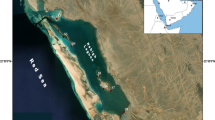Abstract
In this study we compared the accumulation of eight metals and two metalloids in the growing tips and the remaining shoot tissue of three species of brown seaweeds commonly used in biomonitoring studies (Fucus ceranoides, Fucus spiralis and Ascophyllum nodosum). Regression analysis of the data obtained showed that there was no statistically significant difference in accumulation in numerous cases; although most of the relationships were significant, many of the coefficients of determination were low. However, the concentrations of Mn and Zn in the growing tips were closely related to the concentrations in the rest of the tissue in all three species, possibly due to redistribution of these elements. Interspecies differences in bioconcentration of the elements may be partly explained by differences in the relative growth rates.



Similar content being viewed by others
References
Barnett BE, Ashcroft CR (1985) Heavy metals in Fucus vesiculosus in the Humber Estuary. Environ Pollut Ser B 9:193–213
Barreiro R, Picado L, Real C (2002) Biomonitoring heavy metals in estuaries: a field comparison of two brown algae species inhabiting upper estuarine reaches. Environ Monit Assess 75:121–134
Bryan GW, Langston WJ, Hummerstone LG, Burt GR (1985) A guide to the assessment of heavy metal contamination in estuaries using biological indicators. Mar Biol Ass Occ Publ 4
Cairrão E, Pereira MJ, Pastorinho MR, Morgado F, Soares AMVM, Guilhermino L (2007) Fucus spp. as a mercury contamination bioindicator in costal areas (Northwestern Portugal). Bull Environ Contam Toxicol 79:388–395
Ellis SM, Steyn HS (2003) Practical significance (effect sizes) versus or in combination with statistical significance (p-values): research note. Manag Dyn 12:51–53
Falster DS, Warton DI, Wright IJ (2006) SMATR: Standardised major axis tests and routines, ver 2.0. http://www.bio.mq.edu.au/ecology/SMATR/. Accessed 27 July 2016
Farías S, Arisnabarreta SP, Vodopivez C, Smichowski P (2002) Levels of essential and potentially toxic trace metals in Antarctic macro algae. Spectrochim Acta B 57:2133–2140
Hurd CL, Harrison PJ, Bischof K, Lobban CS (2014) Seaweed ecology and physiology. Cambridge University Press, Cambridge
Johnstone KM, Rainbow PS, Clark PF, Smith BD, Morritt D (2016) Trace metal bioavailabilities in the Thames estuary: continuing decline in the 21st century. J Mar Biol Assoc UK 96:205–216
Khfaji AK, Norton TA (1979) The effects of salinity on the distribution of Fucus ceranoides. Estuar Coast Mar Sci 8:433–439
Little C, Kitching JA (1996) The biology of rocky shores. Oxford University Press, Oxford
Martínez-Abraín A (2008) Statistical significance and biological relevance: a call for a more cautious interpretation of results in ecology. Acta Oecol 34:9–11
Morrison L, Baumann HA, Stengel DB (2008) An assessment of metal contamination along the Irish coast using the seaweed Ascophyllum nodosum (Fucales, Phaeophyceae). Environ Pollut 152:293–303
Niemeck RA, Mathieson AC (1976) An ecological study of Fucus spiralis L. J Exp Mar Biol Ecol 24:33–48
Phillips DJH (1990) Use of macroalgae and invertebrates as monitors of metal levels in estuaries and coastal waters. In: Furness RW, Rainbow PS (eds) Heavy metals in the marine environment. CRC Press, Boca Raton, pp 81–99
Rainbow PS (1995) Biomonitoring of heavy metal availability in the marine environment. Mar Pollut Bull 31:183–192
Rainbow PS, Kriefman S, Smith BD, Luoma SN (2011) Have the bioavailabilities of trace metals to a suite of biomonitors changed over three decades in SW England estuaries historically affected by mining?. Sci Tot Environ 409:1589–1602
Raven JA (2003) Long-distance transport in non-vascular plants. Plant Cell Environ 26:73–85
Reis PA, Cassiano J, Veiga P, Rubal M, Sousa-Pinto I (2014) Fucus spiralis as monitoring tool of metal contamination in the northwest coast of Portugal under the European Water Framework Directives. Environ Monit Assess 186:5447–5460
Rodgers JL, Nicewander WA (1988) Thirteen ways to look at the correlation coefficient. Am Stat 42:59–66
Sokal RR, Rohlf FJ (1995) Biometry: the principles and practice of statistics in biological research. 3rd edn. W.H. Freeman and Company, New York
Stengel DB, Dring MJ (2000) Copper and iron concentrations in Ascophyllum nodosum (Fucales, Phaeophyta) from different sites in Ireland and after culture experiments in relation to thallus age and epiphytism. J Exp Mar Biol Ecol 246:145–161
Stengel DB, Macken A, Morrison L, Morley N (2004) Zinc concentrations in marine macroalgae and a lichen from Western Ireland in relation to phylogenetic grouping, habitat and morphology. Mar Pollut Bull 48:902–909
Taylor R (1990) Interpretation of the correlation coefficient: a basic review. J Diagn Med Sonogr 6:35–39
Varma R, Turner A, Brown MT (2011) Bioaccumulation of metals by Fucus ceranoides in estuaries of South West England. Mar Pollut Bull 62:2557–2562
Varma R, Turner A, Brown MT, Millward GE (2013) Metal accumulation kinetics by the estuarine macroalga, Fucus ceranoides. Estuar Coast Shelf Sci 128:33–40
Viana IG, Bode A, Fernández C (2014) Growth and production of new recruits and adult individuals of Ascophyllum nodosum in a non-harvested population at its southern limit (Galicia, NW Spain). Mar Biol 161:2885–2895
Viana IG, Bode A, Fernández C (2015) Ecology of Fucus vesiculosus (Phaeophyceae) at its southern distributional limit: growth and production of early developmental stages. Eur J Phycol 50:247–259
Warton DI, Wright IJ, Falster DS, Westoby M (2006) Bivariate line-fitting methods for allometry. Biol Rev 81:259–291
Whitley E, Ball J (2002) Statistics review 3: hypothesis testing and P values. Crit Care 6:222
Author information
Authors and Affiliations
Corresponding author
Rights and permissions
About this article
Cite this article
Villares, R., Carral, E. & Carballeira, C. Differences in Metal Accumulation in the Growing Shoot Tips and Remaining Shoot Tissue in Three Species of Brown Seaweeds. Bull Environ Contam Toxicol 99, 372–379 (2017). https://doi.org/10.1007/s00128-017-2138-y
Received:
Accepted:
Published:
Issue Date:
DOI: https://doi.org/10.1007/s00128-017-2138-y




